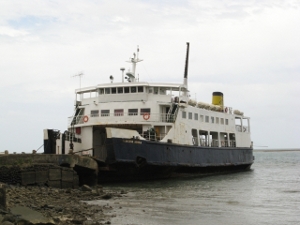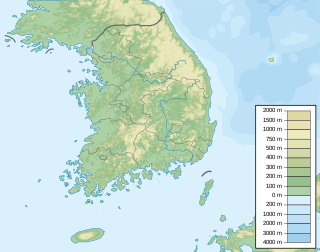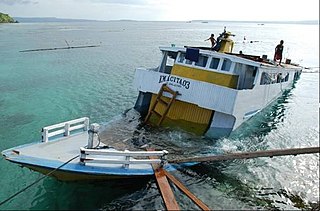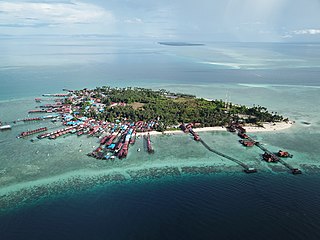
MV Le Joola was a Senegalese government-owned roll-on/roll-off ferry that capsized off the coast of The Gambia on 26 September 2002, with 1,863 deaths and 64 survivors. It is thought to be the second-worst non-military disaster in maritime history.

The MS al-Salam Boccaccio 98 was an Egyptian Ro/Ro passenger ferry, operated by El Salam Maritime Transport, that sank on 3 February 2006 in the Red Sea en route from Duba, Saudi Arabia, to Safaga in southern Egypt.

The MV Senopati Nusantara was an Indonesian ferry that sank in a storm on December 30, 2006. The Japanese-made ship was a scheduled passenger liner from the port of Kumai in Central Kalimantan (Borneo) to Tanjung Emas port in Semarang, East Java. About 40 km (25 mi) off Mandalika Island, the ship sank during a violent storm in the Java Sea. At least 400–500 people are thought to have drowned.

The MV Princess Ashika was an inter-island ferry which operated in the South Pacific kingdom of Tonga. This motorized vessel (MV) was built in 1972, and began sailing the Tongan route on 7 July 2009 only to sink less than a month later on 5 August. Official figures released by Operation Ashika on 19 August 2009, confirmed that 54 men were rescued, and 74 persons were lost at sea. These include two bodies recovered and 72 missing, including five foreign nationals. Two of the missing passengers remain unidentified.
The 2009 Kiribati ferry accident was the sinking, on 13 July 2009, of an inter-island ferry in the south Pacific nation of Kiribati. The accident is believed to have killed 33 of the ship's 55 passengers and crew.

The 2009 Sierra Leone ferry accident occurred on 8 September 2009 off the coast of Sierra Leone, when a wooden Teh Teh ferry travelling from Shenge village to Tombo sank during a storm. At least 90 people to date have been confirmed dead, and over 100 others have been listed as "missing". So far, only 39 survivors have been rescued. Several of the passengers were children who had been on holiday, though the official passenger manifest did not include them. An attempted rescue operation ended on 11 September. The sinking is the worst such accident in Sierra Leone since 2002, when a boatful of refugees capsized. The Xinhua News Agency in China has likened the disaster to other major marine accidents in recent years.

The sinking of MV Dumai Express 10 occurred on the morning of 22 November 2009 when a ferry carrying more than 300 people sank near the island of Iyu Kecil in Karimun Regency, Riau Islands during bad weather. Eyewitnesses reported that massive waves had struck the ferry repeatedly, causing the starboard side of the ship to crack. Subsequently, a considerable amount of water poured into the deck. On 09:55 a.m, the ferry was fully submerged.

On 10 September 2011, MV Spice Islander I, a passenger ferry carrying over 2,000 passengers, sank off the coast of Zanzibar. The ferry was travelling between Unguja and Pemba, two islands off the coast of mainland Tanzania, when it capsized. Early estimates put the death toll at around 200, but a report published by the Tanzanian government in January 2012 claimed that over 1,500 people had been killed.

MV Rabaul Queen was a passenger ferry owned by the Papua New Guinea company Rabaul Shipping. The ship, built in Japan in 1983, operated on short runs in that country, before being brought to Papua New Guinea in 1998 and plying a regular weekly route between Kimbe, the capital of West New Britain, and Lae, the capital of the mainland province of Morobe.

The sinking of MVSewol, also called the Sewol ferry disaster, occurred on the morning of 16 April 2014, when the passenger/ro-ro ferry was en route from Incheon towards Jeju in South Korea. The South Korean ferry sank while carrying 476 people, mostly secondary school students from Danwon High School. The 6,825-ton vessel sent a distress signal from about 2.7 kilometres (1.7 mi) north of Byeongpungdo at 08:58 Korea Standard Time. In total, 304 passengers and crew members died in the disaster. Of the approximately 172 survivors, more than half were rescued by fishing boats and other commercial vessels that arrived at the scene approximately 40 minutes after the South Korean coast guard.

The South Korean ferry Seohae sank on October 10, 1993 in the Yellow Sea near Wido, Buan County, North Jeolla Province. 292 of the 362 passengers and crew on board were killed. 70 people were rescued.

MV Dongfang zhi Xing was a river cruise ship that operated in the Three Gorges region of inland China. On 1 June 2015, the ship was traveling on the Yangtze River in Jianli, Hubei Province with 454 people on board when it capsized in a severe thunderstorm. On 13 June, 442 deaths were confirmed, with 12 rescued. It is the deadliest peacetime maritime disaster in China's history, and the worst maritime disaster since the steamer Taiping sank in 1949, killing more than 1,500.

On 3 December 2016, a PZL M28 Skytruck of the Indonesian National Police disappeared above the South China sea while approaching Hang Nadim Airport in Riau Islands. The aircraft was conducting a flight from Depati Amir Airport in Pangkal Pinang, the capital of Bangka Belitung province. The aircraft was carrying three pilots and ten passengers with no survivors on the aircraft. A search and rescue team was assembled by the Indonesian National Search and Rescue Agency with assistance from Singapore.

MV Sinar Bangun sank on 18 June 2018 in Lake Toba, North Sumatra, Indonesia, during its trip from Simanindo Harbour in Samosir Island to Tiga Ras Harbour in Simalungun Regency. The ferry was carrying 188 passengers and crew. After the sinking, authorities immediately deployed search and rescue personnel to the area. Twenty-one survivors were rescued, three bodies were found and 164 people were listed as missing and presumed dead.

The sinking of MV Marina Baru 2B occurred just after noon on 19 December 2015. The high speed vessel carrying 112 passengers and crew sank off the coast of Bone, South Sulawesi in inclement weather conditions. A nine day search and rescue operation, conducted by authorities, successfully rescued 45 survivors and recovered 65 bodies from the sea. Twelve people were declared missing and presumed dead.

MV Lestari Maju was a modified 10-ton cargo ship that operated domestic passenger service from Bulukumba Regency to Selayar Islands in South Sulawesi. At noon on 3 July 2018, the ship was deliberately grounded off the Selayar Islands. The ferry had reportedly suffered a leak on the port side of the lower deck. As the ferry began to sink, the captain decided to ground the ferry to stop the sinking and ease the rescue effort. The incident killed 35 people; 155 people survived the accident.

MV Nyerere is a Tanzanian ferry that capsized on 20 September 2018 while travelling between the islands of Ukerewe and Ukara on Lake Victoria. The Tanzanian government have declared that 228 people died as a result of the capsizing while 41 could be rescued. The capsized ferry was successfully righted, retrieved and unloaded more than one week after the disaster.

The sinking of MV Wahai Star occurred on the night of 10 July 2007, when a speedboat tugged by the ferry accidentally crashed into its stern, resulting in a major leak. In the following days, rescuers managed to save 43 people, while 16 bodies were recovered in the nearby waters.

The sinking of MV Acita 03 occurred on the night of 18 October 2007 when a ferry carrying 174 passengers and crews accidentally capsized during its docking in Baubau, Southeast Sulawesi. 134 passengers and crews survived the disaster while 30 passengers and 1 crew member lost their lives. 9 people were listed as missing and presumed dead.
























